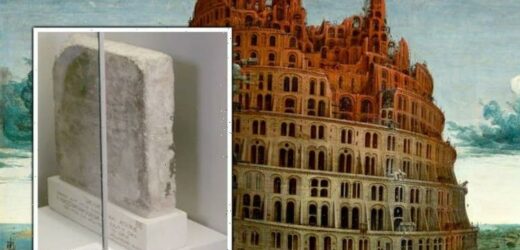Archaeologists find brick which proves existence of Tower of Babel
We use your sign-up to provide content in ways you’ve consented to and to improve our understanding of you. This may include adverts from us and 3rd parties based on our understanding. You can unsubscribe at any time. More info
The tower remains one of the most mysterious elements of the Bible story. It is said to have been a structure built in the land of Shinar — Babylonia — some time after the Deluge. The story of its construction is given in Genesis 11:1-9.
Researchers have since suggested that the story may have been an attempt to explain the existence of various human languages; others claim the tower is pure myth, a metaphor.
There is evidence, however, which suggests that the tower was was constructed under the watch of the great King Nebuchadnezzar II
In 586 BC, in a bid for world supremacy, he laid siege to Jerusalem, which was 500 miles to the west.
His army sacked the city and captured the most highly-skilled and highly-educated citizens.


These people were then brought to Babylon as prisoners of war, and forced to work for Nebuchadnezzar — the start of what is now known as the Babylonian captivity.
Crucially, however, as the Smithsonian Channel’s documentary, ‘Secrets Unlocked: Tower of Babel’, noted: “While in Babylon, the captives became known as the Jewish people — the very authors of the Bible.”
It was from this that another theory about the tower’s later destruction was floated: that the captives went on to write of its destruction in a bid to “rewrite their history”.
Experts believe that the Jews held captive in Babylon after the siege saw the huge tower being built and were at first mesmerised.
JUST IN: Galileo rejection: UK slams door in EU’s face and RULES out return

But, overtime, it is aid to have become a symbol of their oppression.
Dr Irving Finkel of the British Museum said: “When you look at the early chapters of the Bible, it is clear that some of it is drawn from the Judeans’ own records, and some of it incorporates narratives which they must have encountered for the first time in Babylon which were so powerful and striking that the authors, the philosophers who worked on the Hebrew texts incorporated them to tell their own story.”
The narrator noted: “And there’s a compelling clue in the story that backs up a theory that Jewish slaves witnessed the tower being built during their time in captivity.”
An original brick from Babylon that Nebuchadnezzar commissioned, preserved to this day, carries traces of an unusual construction material from the time: bitumen, an ancient tar and mortar.
DON’T MISS
Archaeology: City of Petra potentially destroyed ‘by massive flood’ [REPORT]
Merkel outrage as Germany ‘sourcing gas destined for UK’ [INSIGHT]
Christianity breakthrough as Christ’s Holy Grail disappearance solved [ANALYSIS]


In the book of Genesis, it says they used brick for stone and bitumen for mortar in the tower’s construction.
Dr Finkel claimed that the brick is evidence of the tower’s construction narrative being held in the Bible.
He said: “What we have here is one brick and its bitumen, which fits exactly into that special context.
“There can be no doubt that the stimulus for the story and the narrative must have taken shape during the Babylonian exile.”

This evidence suggests the Tower of Babel was a real building, its story written by a “desperate population in exile held captive by a ruthless king”.
Drawing on the research and Dr Finkel’s conclusions, the narrator said: “The destruction of the tower was their [the captives] way to rewrite history — it’s a fiction rooted in truth.”
The tower’s existence was further evidenced in 2017 when academics were given access to a privately owned tablet dating from 6th century BCE, discovered in Babylon over a century ago.
It perfectly outlined what the tower looked like, and even bore a signature stamp of its creator: Nebuchadnezzar.

Dr Andrew George, an expert in ancient texts at SOAS University of London, was allowed to decipher the cuneiform on the tablet’s surface.
He told the Smithsonian Channel: “At the top part there is a relief, depicting a step tower.
“And here, a great figure of a human being carrying a staff with a conical hat on.
“Below that relief is the text which has been chiseled into the monument, and the label is easily read: it reads, ‘The temple tower of the city of Babylon’.”
The tablet effectively provided the first-ever image of the real Tower of Babel.
Source: Read Full Article


